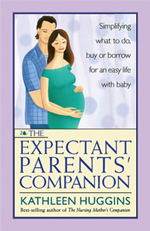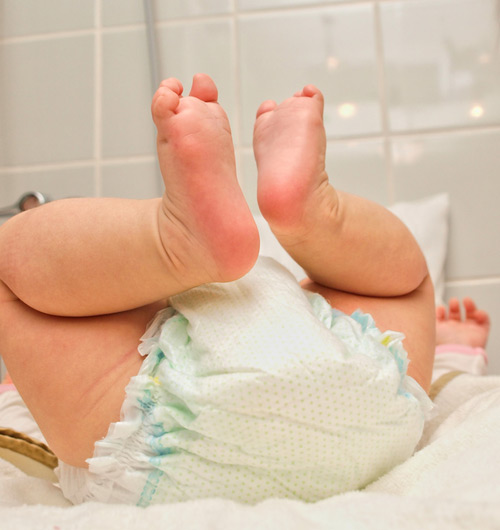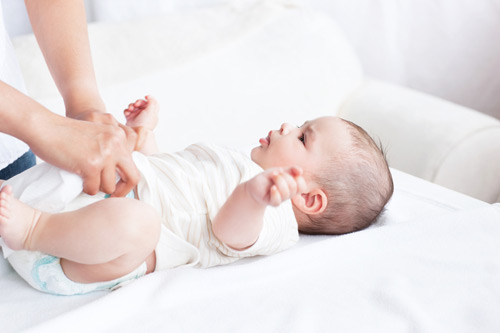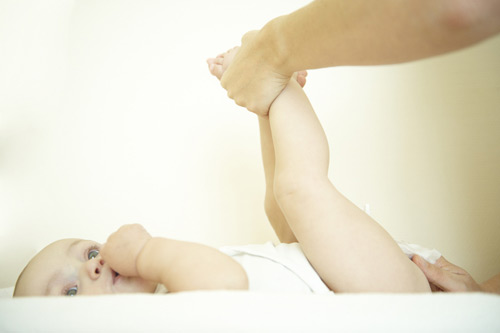Choosing Diapers

[Adapted from The Expectant Parents' Companion, by Kathleen Huggins. Copyright © 2008, used by permission of The Harvard Common Press.]
You and your partner can plan on changing about 2,800 diapers a year for about three years.
You'll need to decide whether to start with cloth diapers or disposables. Today, 95 percent of parents choose disposables, for their convenience. They are expensive, though - about $800 per year. Whether you are more concerned about this cost or about the cost to the environment, you may prefer cloth diapers. Many parents who choose cloth say they prefer having natural, breathable cotton against their babies' skin.
Some parents relieve their worry about the environment by buying organic disposables. Most of these are chemical-free and contain unbleached cotton for absorbency in place of a gel pad. Organic brands include Tushies, Bambo, Moltex, Nature Boy, and Nature Girl. Only the last two are fully biodegradable.
Parents who choose cloth can either use a diaper service, if one is available, or wash their own diapers. Using a diaper service can be as expensive as using disposables. The most environmentally responsible, least expensive way to go is to launder cloth diapers at home.
The diaper question isn't really the either/or sort. Parents who use cloth diapers often use disposables for travel, nights, or both. Disposables can save parents repeated nighttime rousings or frequent sheet changes.

Disposable Diapers
These come in three styles: basic, ultrathin, and premium (or "supreme"). Today, all disposables except the organic ones come with a polymer gel filling that absorbs the baby's urine, so the baby's bottom really does stay dry. Basic diapers are bulkiest but cost the least. Ultrathins are less bulky and more absorbent; they can hold up to 16 ounces of urine. Premiums, which cost about 25 percent more than other disposables, have a soft outer layer that feels like cloth instead of like a plastic bag and Velcro-type closures instead of tape. Consumer Reports finds that most disposable diapers, regardless of style or brand, generally fit well and don't leak.
In the early weeks, you will need about 100 diapers per week. You can buy either newborn-size disposables, which fit babies under 8 pounds and have a special cutout for airing the umbilical cord stump, or size 1 diapers, which most hospitals use. To protect the cord stump with size 1 diapers, turn down the top of the diaper to the outside.
It's easy to stock up on diapers when you do your grocery shopping, but be aware that disposables are cheaper at warehouse stores and other stores that sell diapers in large quantities. Some of these stores have their own brands of disposable diapers, which generally are cheapest of all.
You will want a lidded pail for containing used diapers. A foot-operated garbage pail works well; you might add a charcoal filter or a nontoxic deodorizer cake to reduce odor. Or you can buy a special pail such as the Diaper Genie, which seals each diaper in a scented plastic bag. These pails cost more, of course, and refilling the stock of disposable bags add to the cost (although with some brands you can use standard plastic bags instead of the special scented ones). The lid of a diaper pail should be very difficult for a toddler to open.
Even if you decide to diaper only with disposables, you may want to buy a dozen cloth diapers. They are handy as spit-up cloths and useful for many other jobs.

Cloth Diapers
Despite their decline in popularity, cloth diapers come in an enormous variety of fabrics and styles.
DIAPER FABRICS: Most are cotton - usually gauze, bird's-eye, terry, or flannel. Some are cotton jersey, twill, fleece, or knit. There are even cotton velour diapers.
Choices in Cotton Diaper Fabrics
- Gauze: A soft, loosely woven, finely spun fabric that makes a comfortable, absorbent diaper with good air flow.
- Bird's-eye: A tightly woven, very absorbent fabric that lasts the longest and costs the most.
- Terry: Durable and more absorbent than any of the other diaper fabrics, but also more bulky.
- Flannel: The most popular fabric for diapers. A soft, loose twill weave with a slightly napped surface.
Hemp is becoming increasingly popular for use in diapers because of its durability, absorbency, and natural antimicrobial properties. The coarse fiber comes from the inner bark of the hemp plant. The hemp used in the diapers now on the market is grown without chemical pesticides or fertilizers. The fiber is used to make French terry (terry cloth looped on only one side), fleece, and jersey fabric, all of which are used in fewer layers to make diapers just as absorbent as any made of cotton. Fewer layers means trimmer diapers and a shorter drying time. Because hemp is so absorbent, it has a reputation for stinking. Thorough washing is essential to remove odors.
Some diapers are made of synthetic fleece - Micro fleece, Polartec fleece, and WindPro fleece. All of these are highly breathable, lightweight, durable, stain-resistant, fast-drying, and very soft. They are not, however, absorbent. Heavier fleeces are used for diaper covers and some all-in-one diapers. Lightweight fleeces are used on the inside of some diapers, so the moisture passes through and the baby feels drier.
A cotton-polyester blend popular for diapers is Sherpa terry. This is the brushed, washed terry knit that is used for baby towels. It has a fluffy, very soft feel. Because the cotton content is high, the fabric is very absorbent as well.
Diaper Styles
Cloth diapers come in six styles: unfolded, prefolded, shaped, fitted, all-in-one, and pocket.
Unfolded diapers are large rectangles or squares of thin cotton (flannel, terry, or gauze) or hemp. Many parents prefer these, for various reasons: They cost less; they dry fast; and they are most versatile. You can fold them to fit the baby best, with the thickest part where the baby needs it most. The same diapers, folded in various ways, will fit a baby from birth through toddlerhood. You'll need pins or Snappi clips (which fasten with tiny claws) to hold these diapers in place.
Prefolds are the most popular style of cloth diaper. They are sewn with several layers down the center section, so little or no additional folding is needed. These diapers can be used without pins or other fasteners if you have diaper covers with Velco-type closures.

The best prefolds are diaper-service quality, or "DSQ." These are made of a very soft, absorbent cotton, which comes bleached or unbleached and may even be organically grown. Standard-ply DSQ prefolds are four layers thick on the sides and six layers thick in the middle. Premium DSQ prefolds are four layers thick on the side and eight layers thick in the middle. The very best DSQ diapers are made in China; these are what most diaper services use. Some prefolds sold in stores and labeled "diaper-service quality" are really no such thing. To get true DSQ diapers, buy them from a diaper service or over the Internet.
Shaped, or contoured, diapers have narrow centers and wide wings to fit a baby's shape. They can be pinned, but diaper wraps with Velcro-type closures hold them securely in place. Shaped diapers aren't as versatile as unfolded and prefolded diapers; you'll have to buy at least two sizes before your baby is potty-trained. But these diapers are very easy to use, and when a baby outgrows them they work well as diaper-doublers. You can also use them as inserts in a pocket diaper.
Fitted diapers are made from absorbent fabrics, usually cotton or hemp. These diapers are hourglass-shaped to eliminate folding and are gusseted for a snug fit around the legs. Typically, a soaker pad is either sewn into the diaper or is laid or snapped in with each change. Fitted diapers have attached fasteners, either snaps or Velcro-type closures. Because of the elastic around the legs and waist, fitted diapers prevent leakage better than other cloth diapers do, although they still need an added cover. Like shaped diapers, fitted diapers must be replaced with larger sizes as a baby grows.
An all-in-one combines a fitted diaper with an attached waterproof cover, making a washable diaper that is most like a disposable. All-in-ones are the easiest diapers to use, but also the most expensive. In addition, the waterproof backing makes them harder to clean and more difficult to dry, and blocks air circulation to the baby's skin.
A pocket diaper is like an all-in-one except for the inside pocket, usually made of Micro fleece, in which you place an absorbent hemp insert or a folded or shaped cotton diaper. Provided you remove the insert before doing the laundry, a pocket diaper allows for more thorough cleaning and faster drying than do all-in-one diapers. Both all-in-one and pocket diapers must be replaced with larger sizes as a baby grows.
Diaper Covers
Unless you are using an all-in-one or a pocket diaper, you will need some kind of shell over a cloth diaper, to keep you dry. Fabrics range from waterproof (polyurethane) to water-resistant (nylon or fleece) to very absorbent (wool).
There are two basic styles of diaper covers: wraps and pull-on pants. A diaper wrap wraps around the diaper, from front to back, and closes with Velcro-type closures or snaps. The snug fit makes it unnecessary to pin or clip the diaper beneath.
Pull-on pants have elastic at the waist and legs. If you use pull-on pants with folded or shaped diapers, you must pin or clip the diaper closed. Generally, the most economical diaper covers are waterproof pull-on pants. These used to be made of plastic that would crack and discolor, but today better synthetic fabrics are used.
 PREGNANCY
PREGNANCY  GIVING BIRTH
GIVING BIRTH  BABY CARE
BABY CARE  HEALTH & SAFETY
HEALTH & SAFETY  FUN STUFF
FUN STUFF  FAMILY
FAMILY 